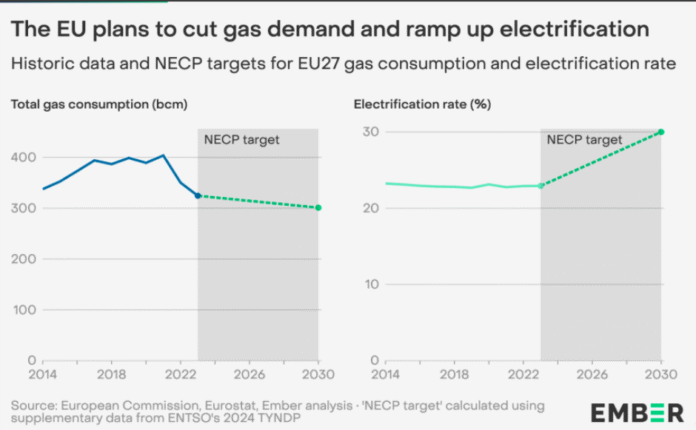European Union is undergoing a structural shift in its energy system that puts future gas infrastructure investments at increasing risk. National plans, policy shifts, and market dynamics all point toward a steady decline in gas demand and an aggressive pivot toward clean electricity and renewable energy, according to a new report by global energy think tank Ember.
Gas Demand in Terminal Decline
EU gas demand is projected to fall by 7 percent by 2030, dropping from 326 billion cubic meters (bcm) in 2023 to 302 bcm. This follows a sharp 19 percent reduction between 2021 and 2023, signaling a sustained downward trend. Ember warns that this reduction could be even steeper if the EU intensifies efforts to cut reliance on Russian energy, as outlined in the European Commission’s post-NECP roadmap.
Despite this falling demand, plans are underway to expand LNG import capacity by 54 percent by 2030. This mismatch risks overcapacity and stranded assets, as new infrastructure may be underutilized or obsolete within a decade.
Electrification Driving Demand for Clean Power
The EU is targeting a rise in electrification from 23 percent today to 30 percent by 2030. This reflects a shift away from fossil gas in sectors like heating, with electric heat pumps replacing gas boilers. As more end-uses are electrified, future energy demand will be increasingly met by renewable electricity rather than gas.
Accelerated Renewable Energy Deployment
To support this shift, EU Member States plan to double their wind and solar capacity by 2030. From 2024 levels of 338 GW solar and 231 GW wind, the target is to reach 670 GW solar and 450 GW wind. Solar deployment appears on track, with 65 GW installed in 2024 alone. Wind expansion, however, will require a significant scale-up, as current annual additions fall well short of the 37 GW needed.
These buildouts are expected to lift renewables’ share of electricity generation from 47 percent in 2024 to 66 percent by 2030 — a substantial rise, though still below the REPowerEU goal of 72 percent.
Near-Term Renewable Energy and Emissions Targets
According to European Commission analysis, the EU is on course to achieve a 41 percent share of renewables in gross energy consumption by 2030, just shy of the 42.5 percent goal under the Renewable Energy Directive. In parallel, emissions are expected to drop 54 percent from 1990 levels, almost hitting the EU’s 55 percent reduction target by 2030.
Investment Risks and Strategic Implications
The divergence between falling gas demand and rising LNG infrastructure investments raises red flags. With national targets clearly favoring electrification and renewables, Ember cautions that new gas projects could become stranded assets. The report calls for policymakers, utilities, and investors to realign strategies with the long-term direction of EU energy policy — one centered around clean electricity, not fossil fuels.
In conclusion, the EU is entering a decisive phase in its energy transition. The strategic focus is now on building out renewables and electrification infrastructure while phasing out fossil gas — a move that redefines the future of energy investment in Europe.
Baburajan Kizhakedath

